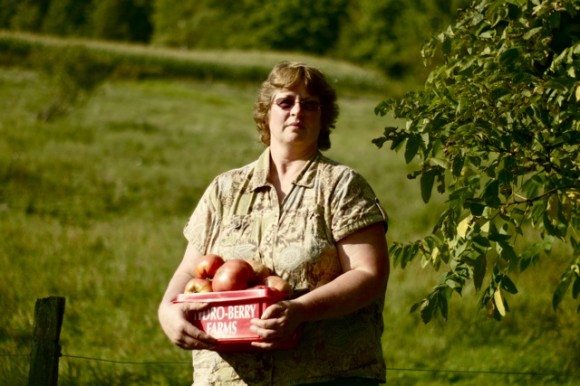A Dairy Farmer Shares Her Story About Fracking:
“What Have We Done?”
Op-ed by Carol French for PublicHerald.org

Carol French stands on her dairy farm in Bradford County, Pa., with heirloom tomatoes harvested from her garden. Once a lease-holder and supporter for fracking, she turned against it after her neighbors began to experience problems and her water became undrinkable. © J.B.Pribanic
Carol French, a conventional dairy farmer in Bradford County, Pa., the county most heavily impacted by shale gas extraction in the state, shares her personal story with you. Her story is part of Public Herald’s +Truth campaign for Triple Divide, a documentary film about shale gas. Find out how you can shareYour Story .
In the early spring of 2006, a nice man was in the area, promoting a chance to dream of better times for Bradford County and its farmers. There was promise of jobs for everyone and the farmer would generate money from signing a lease, and if a gas well was drilled on the farmer’s property he would become rich.
Two years passed with little activity. By now, the older leases were about to expire, gas companies were beginning to drill, and excitement was in the air. Here, the majority of farmers signed early, receiving $5- $85/per acre. There was this belief that the person with the gas well would become the next “shaleionaires.” We later found out small acre properties started signing leases at $2,500/ per acre.
By the spring of 2009, there was uneasiness among some of the farmers who had a gas well drilled on their property. The local newspaper was reporting contamination found in water wells, death occurring on a gas pad and the farmer was facing the fact that he could lose his farm due to a lawsuit based on the gas companies operation. For myself, I was thinking that our lucky neighbor was going to become the next Millionaire, because they had the gas well drilled on them. Soon my mind changed. Those farmers were facing penalties lodged against them, due to their land becoming industrial use instead of agricultural use.
In December, 2010 to January 2011, three gas wells were drilled near our farm. Farmers were seeking out lawyers for advice, because of the gas company’s exploitation of the lease agreement. Many were beginning to question, what have we done? Farm land was getting ripped up like old material for a patch work quilt. In the middle of 2011, five more gas wells were drilled around our farm. Two of the gas wells were less than 4,000 feet away.
Please read the entire Op-ed: http://www.publicherald.org/archives/16845/investigative-reports/energy-investigations/



